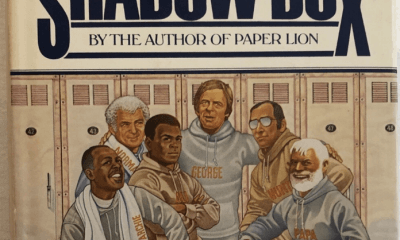Featured Articles
Why Malignaggi Will Beat Broner
Words have been spilled and feelings over-boiled, now it’s time to fight.
Brooklyn’s own Paul “The Magic Man” Malignaggi (32-4, 7 KOs) clashes with Cincinnati’s Adrien “The Problem” Broner (26-0, 22 KOs) on his own New York turf. That’s just one of several advantages the Brooklynite has on Saturday, June 22 at Barclays Center. Showtime will televise.
Broner feels Malignaggi is going to be overwhelmed.
“He’s bringing pillows to a fight that I’m throwing bricks, so you should see a lot of blood,” predicts Broner.
Malignaggi defends the WBA welterweight title he took by knockout last year. Don’t expect him to lie down.
When the Brooklyn fighter captured the title in Ukraine, he wasn’t expected to win let alone emerge with a technical knockout.
“They say I have pillow fists but why don’t they walk right through me if I have no power,” said Malignaggi, age 32.
Most people who have never been hit by a professional boxer, or even an amateur, have no idea what it feels like to have their jaw, temple or nose smashed with a solid punch. They simply go to Boxrec and look at the number of knockouts on a fighter’s resume and deduce the winner.
It’s not that simple.
If it were that easy than how do you explain Malignaggi’s success?
The Italian kid with the gift for gab has shown for a couple of decades an ability to use ring intelligence, skill and one thing that can’t be taught…heart.
“You really find out who you are in the ring,” said Malignaggi. “It brings out the truth.”
Many of the world’s best athletes are front-runners. As long as they have the advantages of speed, power and physical strength they cruise along winning championships as if given by birthright. Then comes along someone with stubborn tenacity who refuses to fold and suddenly, the front-runner finds doubt or it finds him.
That’s where Malignaggi fits in. He’s that athlete that does not fold even under overwhelming power or speed. Think Miguel Cotto or Amir Khan. You didn’t see the Brooklyn fighter asking for a doorway to escape. He was still trying to find the hidden lock to the other fighter’s heart.
Now Broner, is not an attack dog. He’s going to be a little more clever about finding a way to break down Malignaggi’s defense. He got a big lesson against Mexico’s Daniel Ponce De Leon a few years back.
Broner was the big favorite in that fight too. Ponce De Leon was forced to fight two weight divisions higher and consented. They met at the Honda Center in Anaheim and many figured the fight would end in a round or two.
Nope. It went the distance. In that fight Ponce De Leon used movement and counter-punching to out-fight Broner over 10 rounds. Most of the media thought Ponce De Leon won the fight but the judges seemingly mailed in their scores a day earlier.
“I under-estimated him,” said Broner, 23, adding that he expected the smaller Mexican to attack.
Ponce De Leon was the last fighter to go the distance with Broner. All of the others attacked and attacked the counter-punching Broner and found themselves on the floor looking up. Don’t expect Malignaggi to serve up a tray of Broner’s favorite dishes. The New Yorker is a pure boxer and has a great chin.
How good is Broner’s chin? That remains to be seen.
Moving up two weight divisions is not an easy thing to do. Ask Sugar Shane Mosley who accomplished the feat but had a very tough inaugural welterweight test against Wilfredo Rivera in 1999. He was knocking out every single lightweight but that was at 135 pounds. Those guys at 147 pounds are made of sturdier stuff and Mosley eked out a technical knockout win.
“He’s a little guy and he’s going to see how overrated his power was,” says Malignaggi. “I’m not going to tell you that I’m going to sit here and knock him out in one punch, but he’s going to feel a lot of punishment Saturday night.”
-

 Featured Articles3 weeks ago
Featured Articles3 weeks agoAvila Perspective, Chap. 330: Matchroom in New York plus the Latest on Canelo-Crawford
-

 Featured Articles2 weeks ago
Featured Articles2 weeks agoVito Mielnicki Jr Whitewashes Kamil Gardzielik Before the Home Folks in Newark
-

 Featured Articles4 weeks ago
Featured Articles4 weeks agoAvila Perspective, Chap 329: Pacquiao is Back, Fabio in England and More
-

 Featured Articles3 weeks ago
Featured Articles3 weeks agoOpetaia and Nakatani Crush Overmatched Foes, Capping Off a Wild Boxing Weekend
-

 Featured Articles2 weeks ago
Featured Articles2 weeks agoCatching Up with Clay Moyle Who Talks About His Massive Collection of Boxing Books
-

 Featured Articles4 weeks ago
Featured Articles4 weeks agoFabio Wardley Comes from Behind to KO Justis Huni
-

 Featured Articles1 week ago
Featured Articles1 week agoMore Medals for Hawaii’s Patricio Family at the USA Boxing Summer Festival
-

 Featured Articles4 weeks ago
Featured Articles4 weeks agoDelving into ‘Hoopla’ with Notes on Books by George Plimpton and Joyce Carol Oates















